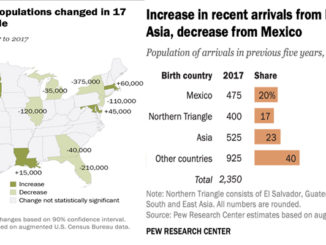
By Ilan Brat
Producers raise wages, enhance benefits, but a worker shortage grows with tighter border
Last year, about a quarter of Biringer Farm’s strawberries and raspberries rotted in the field because it couldn’t find enough workers. Samantha Bond was determined not to let that happen again.
Early this year, Ms. Bond, human resources manager for the 35-acre farm in Arlington, Wash., offered 20% raises to the most productive workers from the last harvest. She posted help-wanted ads on Craigslist, beside highways and on the bathroom-stall door at a church. She also successfully lobbied local high schools to broadcast her call for workers during morning announcements.
Despite Ms. Bond’s efforts, Biringer again faced a worker shortage and typically drew fewer than 60 of the roughly 100 employees it needed on harvest days. “There was definitely hair-pulling going on,” she said.
Ms. Bond’s travails reflect a broader struggle by U.S. fruit, vegetable and dairy farms to secure farmhands as illegal immigration from Mexico declines and a strengthened U.S. economy makes it easier for people to find less backbreaking work, often in areas with cheaper housing costs. In an industry notorious for poor working conditions, farm companies are wooing employees by raising wages faster than inflation and enhancing medical and other benefits. Even so, many farms say these efforts have failed to meaningfully address their worker shortfalls.
Overall in the U.S., the decline in workers is reducing fruit and vegetable production by 9.5%, or $3.1 billion, a year, according to a recently published analysis of government data by the Partnership for a New American Economy, a nonpartisan group that supports a looser immigration policy.
The problem started years ago and was temporarily exacerbated this summer by a glitch that snarled processing for seasonal-worker visas and delayed the arrival in the U.S. of thousands of legal farm laborers, leading to millions of dollars of crop losses in California and other states.
More broadly, growers say they are bearing the brunt of the federal government’s crackdown on illegal immigration, as they lack a suitable alternative workforce. U.S.-born workers unaccustomed to farm labor abandon the job after just days during harvest, farm owners say, and the supply of mostly Mexican laborers that made up for them has shrunk in recent years. That is partly due to tighter U.S. control of its southern border and a declining Mexican birthrate that has decreased the number of young workers heading to the U.S.
Some companies are building housing and providing educational opportunities to attract farm workers. Limoneira Co., the country’s largest lemon grower, says in the past five years it began paying for workers to learn English or to earn vocational degrees at a local community college. The Santa Paula, Calif., company, which is publicly traded, also boosted retirement benefits by 20% and built and rented out to its employees 65 two- and three-bedroom houses at below-market rates in California’s Ventura County, said Chief Operating Officer Alex Teague. It also has raised wages 20% to about $16 to $17 per hour for its 2,000 workers, mostly in California and Arizona.
Still, the company lost about 5% of its crops last year because its diminished workforce couldn’t harvest them fast enough, he said. In a few cases, some workers walked off their jobs because they were offered higher pay at farms a few miles away. This year, Limoneira, which generates about $100 million in annual revenue, has already lost 8% of production to fruit that rotted and fell to the ground, he said.
“We don’t see an end in sight” to the labor problem, Mr. Teague said.
Two years ago, California Artichoke & Vegetable Growers Corp.,which grows vegetables on about 20,000 acres in California, Arizona and Mexico, discovered its work crews were routinely 10% to 15% short of the 30 people needed to fill them, said Joe Pezzini, chief operating officer. So it raised pay 17% to an average of $14 an hour, well above California’s $9-an-hour minimum wage.
The Castroville, Calif., company, which employs 800 to 1,000 farmworkers each year, also began offering $250 bonuses to U.S. employees who recruited other workers who stayed at least three months. The referral program paid out $20,000 last year, but workers remain scarce for the company, which owns the Ocean Mist Farms brand. Roughly 2% of the company’s recent crop output, worth millions of dollars, hasn’t been harvested because of a lack of employees, Mr. Pezzini said.
“Labor has always been an important part of what we do, but there were other resource issues that would take center stage like food safety or water,” said Mr. Pezzini. “But now the highest-priority issue is the availability of labor.”
Nationwide, the average hourly wages for crop workers hired directly by farmers have climbed 5.3% to $11.33, adjusted for inflation, in the past four years, according to U.S. Department of Agriculture data. That runs counter to the overall long-term trend for low-skilled work in U.S. retail and other industries, where there has been little real-wage growth.
Meanwhile, U.S. crop workers’ average age has risen to 38 years old, from 33 in 2000, according to federal data, making them less likely to seek out the most arduous jobs.
Workers like Luis Nuñez have seen a change in attitude among farm owners and supervisors. When the 41-year-old started pruning and doing other work in the vineyards of California’s Napa Valley three years ago, supervisors often frowned on potential distractions like lengthy conversations between laborers or music blaring from radios, he said. But now lively but not-too-loud music and conversations are tolerated. Also, his pay has increased 16% to $12.75 an hour while his employer has begun paying for any health-care treatment he needs at local clinics.
“Things are changing for the better,” Mr. Nuñez said. “If they treat you just a little badly, you go to a different company. There’s work everywhere.”
Manuel Cunha, president of the California-based Nisei Farmers League, an association of farmers, labor contractors and produce-packing houses, said about four of his 900 members have built health clinics over the past three years to keep workers and their families healthy—and to build loyalty.
The federal H2-A visa program, which provides temporary visas to farmworkers, has helped somewhat to fill the gap for farm owners. The U.S. Department of Labor certified a record 116,689 seasonal employees, mostly from Mexico, in the 12 months through September 2014, up 50% from 77,246 in 2011. But growers say it is expensive, burdensome and inadequate because it covers only a fraction of farmers’ labor needs.
A spokesman for the agency said it processes H2-A applications efficiently while ensuring that foreign workers and U.S. workers have basic labor protections.
Some farmworker advocates say they see little evidence of widespread improvement in working conditions. Though labor shortages exist in some areas, labor-rights violations persist and “overall, agricultural employers can still do a much better job of attracting and retaining workers by improving conditions on the job,” said Bruce Goldstein, president of Farmworker Justice, a Washington, D.C., group that works to protect farm laborers.
Ilan Brat writes about agriculture from the WSJ’s Chicago bureau. He focuses on stories relating to fresh produce, dairy, fertilizer and seafood as well as the broader farm economy. He has covered Midwest manufacturing, the garbage industry and packaged-food makers. his email is: [email protected] or follow him on twitter: @IlanBrat




